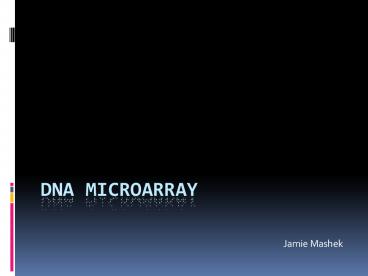DNA Microarray - PowerPoint PPT Presentation
1 / 17
Title:
DNA Microarray
Description:
Jamie Mashek What we will be discussing What is DNA microarray? The purpose of using DNA microarray. The plate. Steps to perform a microarray. – PowerPoint PPT presentation
Number of Views:197
Avg rating:3.0/5.0
Title: DNA Microarray
1
DNA Microarray
- Jamie Mashek
2
What we will be discussing
- What is DNA microarray?
- The purpose of using DNA microarray.
- The plate.
- Steps to perform a microarray.
- Benefits.
- Problems.
3
What is DNA Microarray?
- Scientists used to be able to perform genetic
analyses of a few genes at once. DNA microarray
allows us to analyze thousands of genes in one
experiment!
4
Purposes.
- So why do we use DNA microarray?
- To measure changes in gene expression levels
two samples gene expression can be compared from
different samples, such as from cells of
different stages of mitosis. - To observe genomic gains and losses. Microarray
Comparative Genomic Hybridization (CGH) - To observe mutations in DNA.
5
The Plate.
- Usually made commercially.
- Made of glass, silicon, or nylon.
- Each plate contains thousands of spots, and each
spot contains a probe for a different gene. - A probe can be a cDNA fragment or a synthetic
oligonucleotide, such as BAC (bacterial
artificial chromosome set). - Probes can either be attached by robotic means,
where a needle applies the cDNA to the plate, or
by a method similar to making silicon chips for
computers. The latter is called a Gene Chip.
6
Lets perform a microarray!
- Collect Samples.
- Isolate mRNA.
- Create Labelled DNA.
- Hybridization.
- Microarray Scanner.
- Analyze Data.
7
STEP 1 Collect Samples.
- This can be from a variety of organisms. Well
use two samples cancerous human skin tissue
healthy human skin tissue
8
STEP 2 Isolate mRNA.
- Extract the RNA from the samples. Using either a
column, or a solvent such as phenol-chloroform. - After isolating the RNA, we need to isolate the
mRNA from the rRNA and tRNA. mRNA has a poly-A
tail, so we can use a column containing beads
with poly-T tails to bind the mRNA. - Rinse with buffer to release the mRNA from the
beads. The buffer disrupts the pH, disrupting
the hybrid bonds.
9
STEP 3 Create Labelled DNA.
- Add a labelling mix to the RNA. The labelling
mix contains poly-T (oligo dT) primers, reverse
transcriptase (to make cDNA), and fluorescently
dyed nucleotides. - We will add cyanine 3 (fluoresces green) to the
healthy cells and cyanine 5 (fluoresces red) to
the cancerous cells. - The primer and RT bind to the mRNA first, then
add the fluorescently dyed nucleotides, creating
a complementary strand of DNA
10
STEP 4 Hybridization.
- Apply the cDNA we have just created to a
microarray plate. - When comparing two samples, apply both samples to
the same plate. - The ssDNA will bind to the cDNA already present
on the plate.
11
STEP 5 LASERS!
12
STEP 5 Microarray Scanner.
- The scanner has a laser, a computer, and a
camera. - The laser causes the hybrid bonds to fluoresce.
- The camera records the images produced when the
laser scans the plate. - The computer allows us to immediately view our
results and it also stores our data.
13
STEP 6 Analyze the Data.
- GREEN the healthy sample hybridized more than
the diseased sample. - RED the diseased/cancerous sample hybridized
more than the nondiseased sample. - YELLOW - both samples hybridized equally to the
target DNA. - BLACK - areas where neither sample hybridized to
the target DNA. - By comparing the differences in gene expression
between the two samples, we can understand more
about the genomics of a disease.
14
Benefits.
- Relatively affordable (for some people!), about
60,000 for an arrayer and scanner setup. - The plates are convenient to work with because
they are small. - Fast - Thousands of genes can be analyzed at once.
15
Problems.
- Oligonucleotide libraries redundancy and
contamination. - DNA Microarray only detects whether a gene is
turned on or off. - Massive amounts of data.
http//www.stuffintheair.com/very-big-problem.html
16
The Future of DNA Microarray.
- Gene discovery.
- Disease diagnosis classify the types of cancer
on the basis of the patterns of gene activity in
the tumor cells. - Pharmacogenomics is the study of correlations
between therapeutic responses to drugs and the
genetic profiles of the patients. - Toxicogenomics microarray technology allows us
to research the impact of toxins on cells. Some
toxins can change the genetic profiles of cells,
which can be passed on to cell progeny.
17
Sources.
- DNA Microarray Technology. National Human Genome
Research Institute, 17 Dec. 2009. 19 Feb. 2010
lthttp//www.genome.gov/10000533gt - Microarrays Chipping Away at the Mysteries of
Science and Medicine. National Center for
Biotechnology Information, 27 July 2007. 19
Feb. 2010. lthttp//www.ncbi.nlm.nih.gov/About/pri
mer/microarrays.htmlgt - Brown, P.O. Botstein, D. Exploring the New
World of the Genome with DNA Microarrays. Nature
Genetics Supplement. 21. (1999) 33-37.
lthttp//www.ctu.edu.vn/dvxe/Bioinformatic/PDF20F
iles/Volume21/ng0199supp_33.pdfgt - Simon, R., Radmacher, M.D., Dobbin, K.,
McShane, L.M. Pitfalls in the Use of DNA
Microarray Data for Diagnostic and Prognostic
Classification. Journal of the National Cancer
Institute. 95. (2003) 14-18.
http//jnci.oxfordjournals.org/cgi/content/full/95
/1/14 - Holloway, A.J., Van Laar, R.K., Tothill, R.W.,
Bowtell, D.D.L. Options Available From Start to
Finish For Obtaining Data From DNA Microarrays
II. Nature Genetics Supplement. 32. (2002)
482-489. lthttp//web.cs.mun.ca/harold/Courses/Old
/CS6754.W04/Diary/ng1030.pdfgt































